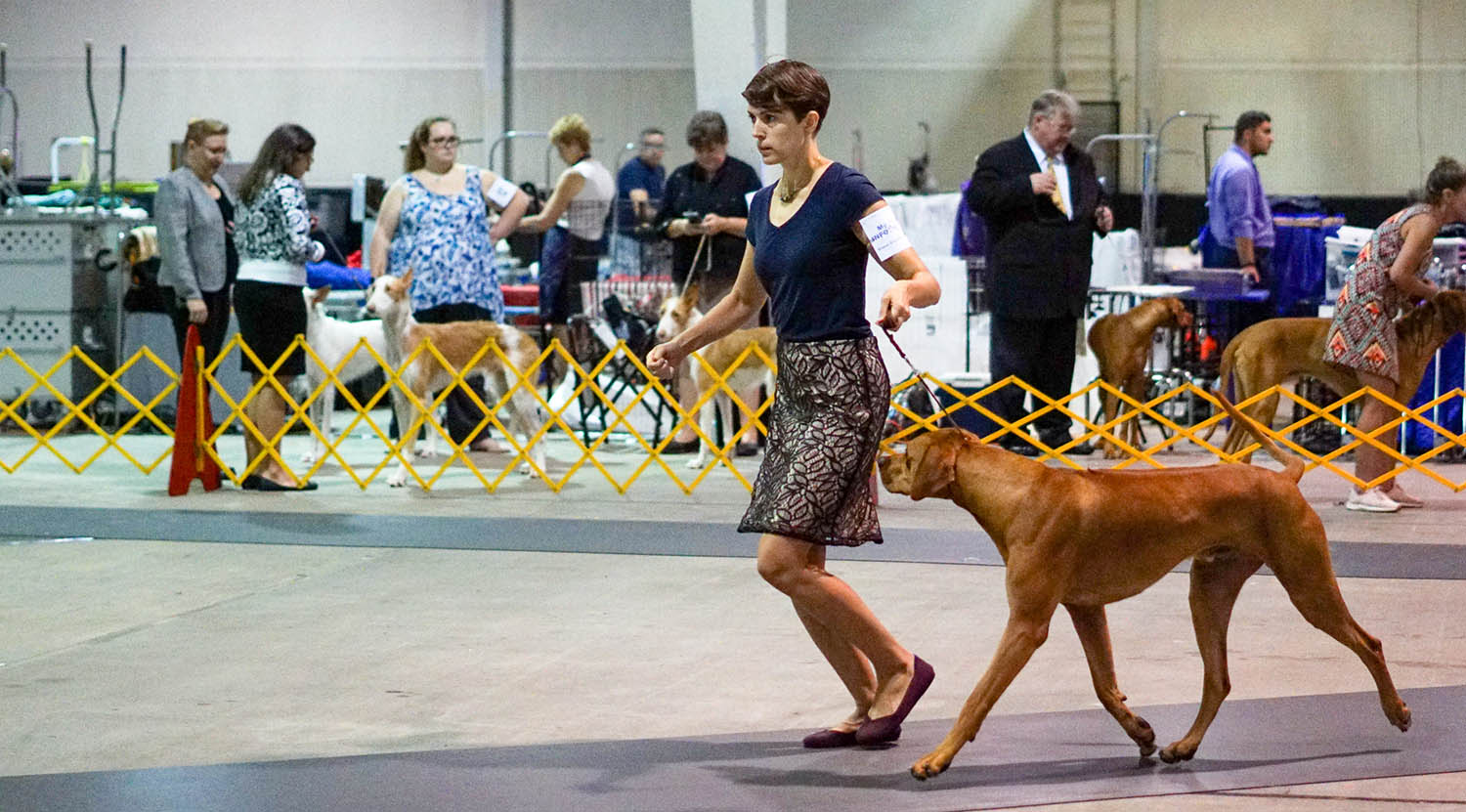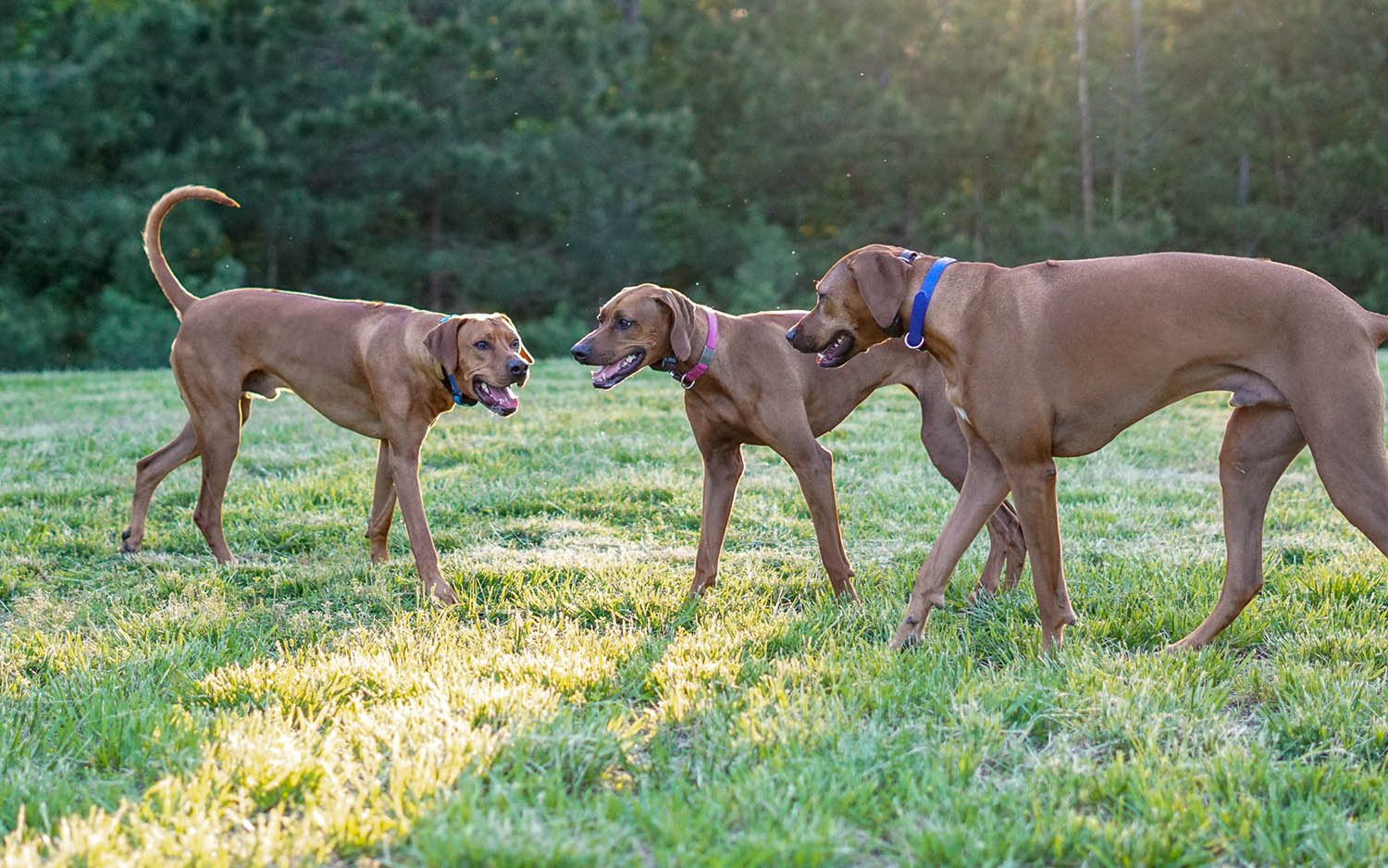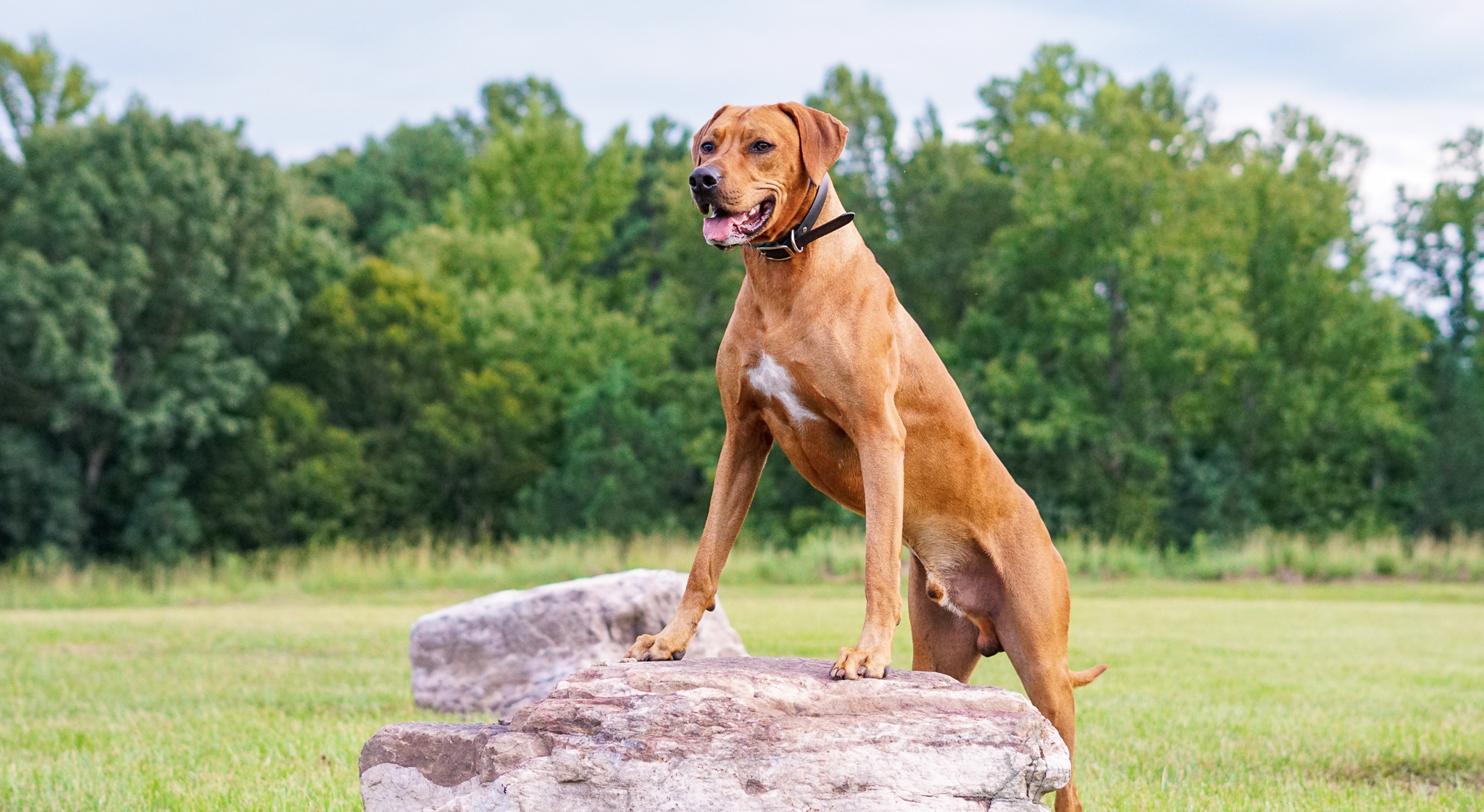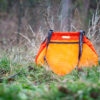My Rhodesian ridgeback, Colombo, is three years old. He’s also intact. I know we are in the minority, because for most dog owners in the U.S., owning a three year old intact male dog is not something they would ever fathom.
Before we got Colombo, my husband and I knew that we wanted to keep him intact. With the issues we’d had with Zara after spaying her, we were reluctant to neuter him. I’d also read a lot about the risks of neutering large-breed dogs, especially if the neutering was done at a young age.
Colombo is also a show dog, and in order to show in conformation events, dogs must be intact. At some point, he may be bred, although he needs to finish his show championship and complete all of the recommended health testing before that would be considered. We have no plans to neuter him unless there is a medical reason, such as testicular cancer.
For the most part, living with an intact male dog has been uneventful. However, I have learned several things about intact males in the past three years that I did not know before having one.
Neutered Males Can Be Problematic
Before I owned an intact male dog, I had no idea that a lot of neutered males don’t like intact males. We learned this the hard way with Colombo when he was about a year old. At that point, we still took him and Zara to the local dog parks fairly regularly. Colombo LOVED to play with the other dogs when he was a puppy. One day, we were at one of the large parks when another dog started getting aggressive with Colombo. They had run to the other end of the park, out of earshot. I got to them as quickly as I could. The other dog, a large male pointer, was growling and getting in Colombo’s face. Colombo was not scared and was growling back. I grabbed him and tried to pull him away but the pointer just kept advancing. Eventually, I yelled for help and a man came and pulled the pointer back.
Thankfully, neither dog was hurt, but the incident was scary. Afterward, I did some online research and discovered that neutered males are often aggressive to intact males. When males are neutered, they smell female to other dogs. Since most of the dogs in this country are spayed or neutered, the majority of dogs smell female to each other. It makes sense that when a neutered male encounters an intact male, they smell male, and thus different.
This is the main reason I rarely go to dog parks now. Colombo will not initiate a fight with a neutered male, but if one tries to start one with him, he won’t back down. It’s not worth the risk, because I have no idea which dogs will not like him.

Colombo and I at a conformation show
Some Intact Males Don’t Like Other Intact Males
Colombo is not a fan of other intact male dogs, although it’s mostly with other large intact males. He will start growling aggressively. It’s never escalated beyond that because I’ve never let it. He’s been okay with smaller intact males. He also interacts with other intact males at daycare, and the daycare staff have told me that he’s not had any issues. Because of this, I wonder if me being around or him being on a leash makes him feel like he has to defend himself.
With that said, not all intact males are like this. I know several people who also have intact male Ridgebacks and they are fine playing with other intact males. So it really depends on the dog.
It is Possible to Find a Daycare or Kennel that Allows Intact Dogs
As I mentioned above, Colombo goes to a daycare that allows intact dogs. The majority of daycares and boarding kennels in the U.S. require dogs to be spayed or neutered at six months of age in order to attend. This is one of the reasons people chose to spay or neuter their dogs early. However, I think it’s worth looking around to see if you can find one that does allows intact dogs before making the decision. When we lived in the DC area, Zara attended a vizsla-only daycare (yes, that exists and it’s called Vizsland) and the owner allowed her to come before she was spayed. Especially for small, in-house or farm daycares/kennels, it’s worth asking if the owner would allow an older intact animal to attend if they are not a problem.

Colombo (left) and two of his ridgeback friends
Yes, Intact Males Mark
Another reason people often want to neuter their male dogs is to reduce marking. I personally don’t find this a compelling reason to neuter a dog. Yes, Colombo does love to pee on every bush in the neighborhood if we let him. But he’s never marked inside our house or anyone else’s house. And it’s not always a male behavior. Zara started marking when she was two years old, and now lifts her leg just like a male. Marking inside the house is likely a house-training/behavior issue.
Yes, Intact Males Sometimes Hump
Humping is another behavior that people often want to eliminate by neutering their dogs. While it is true that neutering can reduce it, Colombo’s humping has never been excessive enough to bother me. He started when he was about six months old, trying to hump other male and female dogs at the dog park. I was vigilant about correcting the behavior every time he attempted it, using a “settle down” command. His desire to hump seemed to peak around 14 or 15 months and has since decreased. He occasionally does it at daycare, but the staff tells me that he listens well when they scold him.

Colombo poses at the 2019 Rhodesian Ridgeback National Specialty in Huron, Ohio.
There is Some Discharge
Sorry for the gross visual, but an intact male dog’s penis often has some yellowish-green discharge that can be seen on the end of it. That is normal. It’s not a lot, but sometimes I find spots of it scattered around the house on the floor. Colombo is usually pretty good about cleaning himself down there, though.
Recall is Very Important
A solid and reliable recall (“come” or “here” command) is important for any dog, not just intact ones. However, as the owner of an intact male, I feel that it’s my responsibility to be extra-careful if Colombo is off-leash. Since intact males can smell females in heat from long distances, I never want to be in a situation where Colombo chooses to run off in search of a mate. Since ridgebacks are not known for a natural recall (they were bred as independent, prey-driven hounds), I choose to use an electronic collar on Colombo any time he is off-leash. Most of the time, he comes right away when I call him. But the e-collar ensures that I have 100% compliance and peace of mind.

Colombo and Zara romp off-leash on the beach.
Owning an Intact Male Dog is Actually Not a Big Deal
For the most part, owning an intact male dog has been easy and very manageable. His negative behaviors are all controllable with training. I thought about this when I was at a conformation dog show with my mom two years ago. At this particular show, we were in a large exhibition building, crammed full of rings, grooming set-ups, crates, and people and dogs everywhere. There were probably 1,000 dogs entered in the show that day. I had been to several dog shows prior to this, so I wasn’t fazed by the environment.
“I can’t believe how well-behaved all these dogs are,” my mom remarked. There were hundreds of dogs in the building and it was peaceful. Well, as peaceful as a dog show can be. Sure, there was plenty of barking and noise, but no dogs were fighting and everyone was moving around each other without issue, holding their dogs by skinny show leads. Every dog in that show was intact. That is just one example of how training and socialization can make a huge difference in the way a dog behaves, regardless of they have their sex organs or not.
I do not regret keeping Colombo intact. I will certainly watch out for testicular cancer, and if he does develop it in the future, we could always neuter him then. Testicular cancer is more common in dogs with one or more undescended testicle (which Colombo doesn’t have) and it often doesn’t spread. To me, the health benefits of keeping him intact far outweigh the negatives.
Do you own an intact male? Have you had any issues with him or has it been a positive experience? Leave me a comment below!







I had Remy my weim neutered at 10 months. I wish I’d waited a bit longer but I’m glad I didn’t do it any sooner. The contract with his breeder required us to have him neutered by 1 year. I probably couldve negotiated this but it seemed ok to me at the time. Our vet actually encouraged me not to neuter him, which was nice to hear since I think most vets still encourage early spay/neuter.
Anyway, I had no issues with him when he was intact except owners of neutered males (always women) were often nervous. They would yell at us, “intact male! My dog doesn’t like intact males!” It seemed obvious they were actually triggering a reaction by acting this way. My dog sometimes growled back at these dogs, sometimes just tried to get away. It happened enough where this was a factor in my decision. Plus, I also wanted to take him to a dog daycare and they all required neutering.
Another comment a few people made was that they thought my dog’s extremely high energy was because he was intact. His energy was INSANE when he was a puppy, as you know with these pointing breeds. I was pretty sure his balls had nothing to do with his energy, and I was correct. His energy did not change after his neuter.
Hi,
We have an intact male McNab. We have to maintain a well-fenced yard or he takes off chasing prey or adventure. The neighbors say he is like a bullet.
He has a “six-pack” like your Columbo. Beautiful physique. By the way, what kind of dog show were you at where there were other intact dogs? Is that standard for dog shows?
Thank you for writing this. Very interesting.
Hey Judy! What breed is McNab? Colombo also would take off chasing deer or squirrels but I’ve trained a good recall and I only let him off leash in safe areas. Plus the e-collar is a back-up. So, for the most part, all dogs at conformation shows are intact. You can’t show a dog that’s been neutered or spayed. Occasionally there are classes that allow an altered dog (like a “field trial” class) but that’s not the norm. Conformation was originally designed to evaluate breeding stock. So all the animals needed to be intact.
McNabs resemble large border collies. I and never heard of them until I met one in Ragle Park, Sebastopol, California. Lovely dog. I think the breed was developed in Mendocino county. You can look them up for more information.
Oh interesting! I had no idea.
McNabs resemble large border collies. I and never heard of them until I met one in Ragle Park, Sebastopol, California. Lovely dog. I think the breed was developed in Mendocino county. You can look them up for more information.
Our moyenne Aussiedoodle Oskar is intact…and as friendly/affectionate as can be. He will be 3 in June, and has already been e-collar trained. We got a puppy from a breeder specifically so we could give him his best life and not remove bidy parts thst are crucial to his good health. Neutered dogs sometimes give him a hard time, but he calmly stands there and waits. I am convinced that castration is very harmful to dogs and does not solve behavioral issues, but causes medical ones. Dogs are so amazing to us…we owe them the best life we can provide.
Hi Judy,
How would you handle Intact dogs(both sexes) under 1 roof? I have an intact female and she’s never been a problem. Once or twice a year diapers and in doors for a month. I’m thinking of getting a male and was curious how or if you handle that situation?
Hi Shawna,
I haven’t personally had two intact dogs of the opposite sex. There are two main ways to deal with it. One is to send one dog away to stay with a friend for a few weeks (likely the male). This is probably the best option and will keep everyone happier. Other people keep them together, but they are never out at the same time. One is always SECURELY crated. But I’ve heard that this can be a major pain since the males often get so worked up that they’re constantly whining and won’t eat. I think it depends on your long term plans, too. If you plan on spaying the female after one or two heats, or neutering the male when he’s two years old or so, you can probably deal with it for one or two heat cycles. Living with two intact dogs over years and years is more of an undertaking I would think!
Hope that helps.
Terry Ann
Hi Terry Ann & Shawna,
Very interesting. Thank you! In answer to the question re. how to have both sexes, I would follow a lady’s example who had 2 intact females. Their cycles were in sync. She said you can tell when they are in heat because their coats glisten and neighborhood male dogs go cuckoo, lick the genitals and try to hump them. Time to lock up the females. Or you could have two males. Having one male and one female has been challenging. I don’t recommend it! Things were going well til we had to be away. The dog sitter didn’t get it and the female got pregnant. (Registered McNab puppies free to good homes, anyone?) Another option is vasectomy for males. Preserves the hormones. And tubal ligation for females. I found a vet who does this. By the way, do you have a suggestion for a brand for the electronic collar? Lastly, how do learn when/where these dog shows you refer to are? Thank you!
Judy
Judy, check the AKC website for the conformation show calendar. Are you in Northern California? I know that is where there are McNabs. The Solano county fairgrounds host dog shows periodically, among other locations.
We are caring for a retired show dog and I found this blog while looking for information about intact males. He is a sweetheart and if things work out, we will keep him. I have had other intact males, but had not noticed some of the characteristics this one has.
My trainer friend in the Bay Area also has Ridgebacks, intact, of both sexes.
I think neutering dogs is a trick by the cat & dog military industrial complex to allow more people to think they can own dogs most of who are not capable and should not have a dog. Between eating garbage they sell as dog food vets who know nothing but drugs and unnecessary vaccinations and surgeries and owners who do not provide what their dogs need -leadership exercise and breed specific mental exercise most dogs in USA are miserable
Hi,
I agree that there are lot of issues with pet ownership in the US. Many people do not train their dogs and a lot what vets promote is outdated, such as neutering at six months no matter what.
I have a six year old intact boxer, Milo. A lot of male dogs are reactive to him and he in turn to them. The problem is that he remembers these dogs, where they live, behind which fence, and his fur stands up on his back before we are within up to a half block. I’ve had hit and miss encounters. I know where they are on my path but I can’t see to train him, distract him, etc. out of this behaviour. I’ve changed routes etc. but there inevitably ends up being another male dog in a different neighborhood behind a fence, etc. any suggestions? I’ve had to switch back to the pronged collar because of this behaviour, he’s 95 lbs, all muscle and has popped my elbow and taken me to the ground if I’m not ready for a reaction. Thank you in advance for any tips. He loves treats but could care less in that situation. He is hyper focused.
Hello there,
I have an intact Weimaraner named Mars who is about to turn two years old this coming Saturday! Today we had our first incident at the dog park he has been going too since he was 8 months and it was the most stressful and unpleasant thing ever. He was greeted by a beautiful big black dog who was friendly with him and as Mars ran a little further into the park he immediately return to me as another dog aggressively ran to him and then like 4 additional medium to small size dogs attacked him. The owners of the dogs were on the other end of the park and it felt like an eternity for them to reach me and help me get these dogs off. I attempted to back off an call Mars to me but he was soo scared and at that point I attempted to get these other small dogs off of him. When I was able to get him to safety, a few older women came over checking to see if he was ok and when they realized he was intact they immediately started acting as if he was the problem but I know that he was not in the wrong nor did he approach any of those other dogs. It really upset me but I choose not to say anything as I wanted to remain calm for Mars and ensure he was ok. All in all, no more dog parks for us and more practing our recall.
Thank you for sharing!
Hi Stephanie!
Unfortunately I think your experience is rather common. I’m glad to hear that Mars is okay. Yeah, dog parks are great in theory, but oftentimes they are not the best in practice. I’m sure you’ll figure out ways to keep Mars entertained outside of the dog park. Good luck!
Terry Ann
Hey Terry Ann,
Great article! As you know, I have an intact GSP male, Kaiser. Cancer risk is the big factor we worry about regarding leaving him intact. I would prefer leaving him intact, since it is natural for him to have that organ in the first place. What is suggested to routinely check for cancer and other illnesses related to remaining intact?
Thank you!
Hey Nick! Glad you enjoyed it. I think the main cancer risk for intact males would be testicular cancer and perhaps prostate cancer. I would keep an eye on that area and if anything seems off, have it checked at the vet. If needed, they could neuter at that time. Maybe also ask your vet to examine his testicles at your once a year wellness visit too to make sure everything is normal.
Hi! Additionally I would throw in that according to what I’ve read, leaving a male dog intact aids the immune system (as in humans, the endocrine system plays a huge part in the immune system). I’ve read that cancers that your dog’s natural hormones guard against are far deadlier than testicular cancer, which, as Terry Ann pointed out above, does not have a high mortality rate if caught- you just want to watch for changes and have your vet check when they’re in for an exam. Additionally, intact males have greater tolerance to vaccines (I titer, with the exception of rabies and leptospirosis, but still).
From what I’ve read (please correct me if I’m wrong), the ladies don’t fare as well, though. Mammary cancer in females is quite deadly, so when weighing in on that, I’d say spay at the 18-24 month range for a female. Still allows for growth plates to close, bones to calcify, etc., but to me, the risk of mammary cancer in a female outweighs the benefits of leaving her intact. Just weighing in here.
Hi! I have a 1.5 year old Golden Retriever who is intact. I also feel like it’s their natural state and prefer not to neuter. However, I worry that without being able to release it might be cruel/harmful because that’s also the natural order of things. What do owners if intact dogs do so that they can release?
Thanks,
Sonya
Hi Sonya!
What do you mean by release? Do you mean having them be off-leash safely? If that’s the case, then teaching a bulletproof, reliable recall is the first thing you need to do. Your dog should come to you when you give it a “come” or “here” command, no matter what. Practice in low-distraction environments first and then build up to higher distraction areas. Once the recall is very reliable, you can try having him off-leash in safe areas. Also keep in mind that 18 months is typically the “teenage phase” for large dogs! So they may not always listen well and get distracted easily. That will be get better over time!
Terry Ann
Actually, I think she’s referring to ejaculation. She’s concerned that leaving a male intact with the inherent desire to reproduce is cruel or unkind.
ah okay, good call! LOL.
Hello! I have German Shorthaired Pointer Maverick who will be 2 in October who is intact, however we do have an appointment for his neuter on the 27th of this month. We also had a bad experience when we spayed our female GSP at the “usual” 6 months of age, so I’m pretty nervous about it. Plus, I waited to have him neutered because I’ve learned a lot since spaying our female 5 years ago, and know now it’s best to wait until they’re older and have finished growing. I stumbled on your blog tonight and now I’m second guessing whether to have him neutered or not. So far he hasn’t been too hard to handle, except all the usuals that you have mentioned, humping being our biggest issue so far. The only reason to have him neutered for us really is the fact that no boarding facility near us will take an intact dog, and a vacation would be nice at some point! Haha.
Thanks for the blog and all the information, Columbo is a handsome boy!
Becky
Hey Becky!
I think it’s definitely a good thing that you are waiting until your boy is 2. By that point, he should be fully grown. Our vizsla developed the spay-induced urinary incontinence after we spayed her, so I get your hesitation. I don’t think that is very common in males, though. Your life will definitely be easier with neutered – I understand about the boarding situation.
Glad you enjoyed the post!
Terry Ann
Thanks for your post! I’m a first-time dog owner with a 25-pound French Maltipoo mix, and despite recommendations from my vet and friends, I’ve decided not to neuter him because I prefer to keep him in his natural state. I’ve read a lot of stories from both sides—some negative experiences with intact dogs and ‘miracle’ results from neutering—but I’d like to share my own positive experience with Zion, who I don’t plan to breed.
Zion is the best puppy, and since I work remotely, we spend a lot of time together. I reinforce his basic training daily, and he still listens just as well as when he was a pup. He’s a happy dog, and I make sure he is not bored! He is playful, enjoys puzzles, and hasn’t destroyed anything in my apartment (yet!). At our enclosed park each morning, Zion’s the dog that brings out the playfulness in all the others, regardless of size, age, or breed. (Yes, I have noticed that some intact male dogs will growl at him, and so we just go our merry way). We’re working on recall with high-value treats, and so far it’s been great—though he did get a little distracted by a female dog once!
Yes, Zion marks a lot, but in NYC, there’s plenty to pee on, so it doesn’t bother me. I correct him when he humps other dogs or friends, which has improved since he was six months old. He’s smart and listens well—just seeing the pet corrector can now stops him after using it only twice. My trainer, who used to breed dogs, is firm on waiting until at least age two to neuter, regardless of size, and explained that humping is more about behavior and dominance than anything neutering can guarantee to fix.
That’s my positive experience so far with my 11-month-old puppy! I’ll continue to monitor his health closely with my vet, especially as he ages, and stay vigilant about signs of cancer. I’m hopeful that with advancing technology, early detection and effective treatments will only get better.
Love this! My intact male lab is the best dog! He is so well behaved, very friendly, and super social. We decided not to neuter him to keep his confidence and keep his testosterone to burn those calories since labs are prone to get obese. He’s almost 5. We were endorsed by 3 vets and our training facility to keep him intact. We’ve had no issues except for the old-school neighbors who complain about him being intact. It’s ridiculous.
It’s funny somehow people think because he’s intact he must not be well cared for when he’s the most spoiled dog I have ever known. In the end I believe it’s going to be so much healthier for him and contrary to popular belief he does not jump over fences to get to a female.